By Chris Punnett
2006 marks the 100th Anniversary of the quintessential American 20th Century military cartridge. While outdated by modern cartridges it has been kept alive by nostalgia and the deep affection of shooters and collectors the world over.
The average gun enthusiast may be forgiven for wondering what all the fuss is about. After all, didn’t the .30-06 start its service life with a 150-grain spitzer bullet and end its service life with basically the same 150-grain bullet? Well, yes it did, but for the first 50 years of its service life it was available in a myriad of military loadings and for the following 25 years it was used as a vehicle for testing ideas in small arms ammunition development. By the turn of the 21st century, its military use was limited to training purposes and for military salutes.
This article will focus on the U.S. military evolution of the .30-06 and only briefly touch on non-US development and civilian use. Even so, this will be a superficial look at the official U.S. rifle and light machine gun cartridge through two World Wars and countless “Police Actions.”
Politics and Cavalry Charges
To look at the use of the .30-06 around the world is a lesson in geopolitics. Its spread around the world didn’t really occur until after WW2 when the U.S. sought to influence foreign governments, either to stem the spread of communism or to develop trade – and what better way than to provide these friendly governments with your excess munitions. Eventually the .30-06 was used in almost 50 countries.
Even a cursory look at the various .30-06 loadings and how they were developed illustrates the changing face of warfare through the 20th Century – from cavalry charges to “dirty tricks.” The development of the .30-06 through the 1920s and 30s reflected the lessons learned during WW1. However, by the advent of WW2, cavalry charges had been relegated to the history books and the importance of the aircraft was becoming obvious.
During WW2, the diverging requirements of ground, air and sea warfare often resulted in serious development and production delays for the various .30-06 loadings. Basically, they were trying to have a single cartridge do everything.
As the U.S. became more and more involved in S.E. Asia after Korea, it seems that running wars became the province of the intelligence agencies and not the armies, navies and air forces actually doing the fighting.
The .30-06 was replaced by the 7.62mm NATO round in 1954 and U.S. military production for combat use ceased in the 1960s.
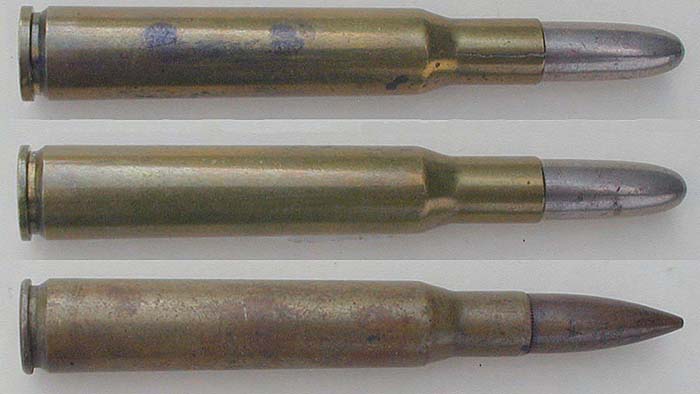
Modest Beginnings
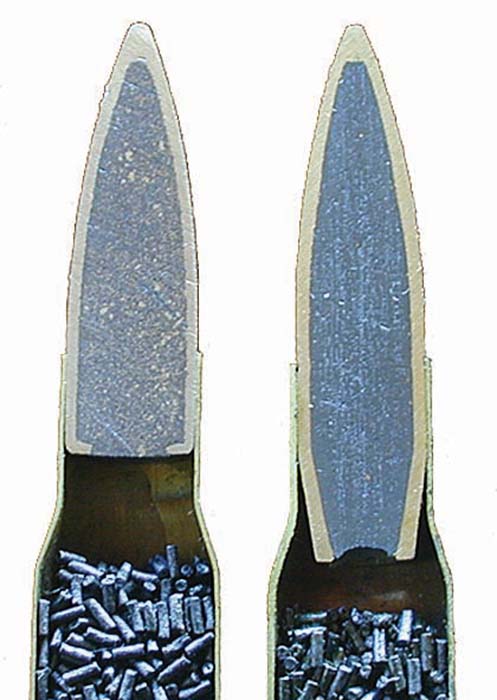
The .30-06 was the result of several basic developments that occurred in the late 19th Century: the use of smaller caliber weapons; smokeless powder and rimless cases. The move towards smokeless powder came with the .30-40 Krag introduced in 1892 but this had limited powder capacity.
By 1901, Frankford Arsenal in Philadelphia (the government facility where the majority of ammunition development took place) had developed a rimless .30-caliber round. This was adopted as the .30 Ball Model of 1901 and commonly referred to as the “.30-01”. It used a 220-grain round-nose bullet and it had a thick rim – much thicker than contemporary rimless cartridges. At this time, Springfield Armory was also developing what would become the .30 Rifle, Model of 1903. The .30-01 was also further developed, losing its thick rim but retaining the 220-grain round-nose bullet to become the .30 Model of 1903 – or “.30-03”.
With the rest of the world pursuing pointed bullets, it only took a couple of years for someone to stick a pointed bullet into a .30-03 case that had the neck shortened by 0.10-ins to accommodate the reduced bearing surface of the pointed bullet. Things were simpler in those days and on October 15, 1906, the resulting cartridge was approved as the .30 Cal. Model of 1906, what we now call the “.30-06”.
Loadings
Before discussing the various loadings, we should mention colored bullet tips. The U.S. used these to identify various loadings in the .30-06. The following is a list of the colors used on service rounds and their meaning. Caution is advised if you are using this list to identify a loading as other countries did not always follow U.S. marking practice.
Common U.S. .30-06 Bullet Tip Color Codes
- Black: Armor Piercing (AP)
- Black/Silver: AP Plate Test
- Blue: Incendiary
- Green: AP for UK
- Green/White: Frangible
- Green/Tan: Frangible
- Orange: Tracer
- Red: Tracer
- Silver: Armor-Piercing Incendiary (API) and Navy contract Ball (1941)
- White: Tracer (and unfinished Frangible)
- Yellow: Observation
BALL
The first ball round for the .30-06 used a 150-grain flat-based bullet with a cupronickel jacket. This is referred to as the “M1906” bullet and it remained in use through World War I.
The use of machine guns at long range in that war revealed that the .30-06 was outclassed by rounds firing heavier bullets. Thus, in the immediate post World War I period, the U.S. experimented with heavier bullets. They tested many variations and it is amusing to note that one of the rounds tested at this time used a modified round-nose Krag bullet. The result of these tests was the adoption, in 1925, of the 172-grain boat-tailed “M1” bullet which had a gilding metal (a copper alloy) jacket.
By the mid-1930s it was evident that the use of machine guns at long range was a thing of the past and the recoil of a 172-grain bullet would be uncomfortable for the average GI. As a result, the original 150-grain M1906 bullet was re-adopted in 1937, though it did now have a gilding metal jacket. At first the original nomenclature “M1906 Ball” was used, but this was quickly changed and this new bullet was called the .30 M2 Ball. The 172-grain M1 bullet didn’t go away and continued to be used by the Navy. Initially, M2 ball rounds used a stannic (i.e.: tin) stained bullet to identify them from the M1 and this staining lasted until 1940. To further confuse matters, one of the last lots of M1 ball rounds produced by Frankford Arsenal in 1941 for the U.S. Navy had silver-tipped bullets. These should not be confused with silver-tipped API rounds which didn’t appear until 1943.
During World War II, because of supply problems with strategic materials like copper, the use of a steel bullet jacket was permitted. The jackets were given a gilding-metal plating and are referred to as the “.30 M2 Alternate” – a name which often appears on packaging. Though the supply of copper improved, the M2 Ball and the M2 Alternate Ball bullets continued to be used for the remainder of the .30-06’s military career.
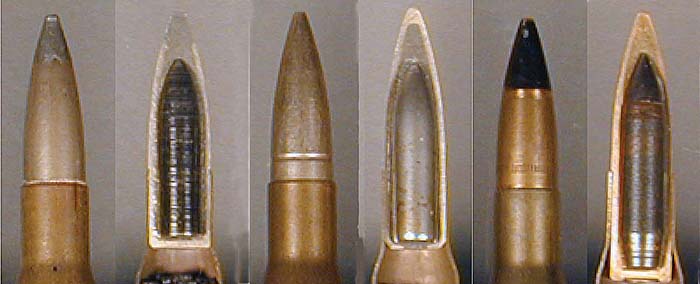
ARMOR-PIERCING (AP)
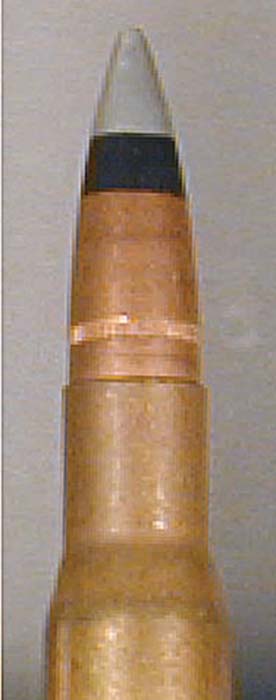
The first AP round produced in service quantities in the U.S. was the controversial M1917 which had a cupronickel jacket with an exposed lead tip. Since The Hague Convention of 1899 effectively banned the use of expanding bullets on personnel, there were significant worries from the front lines to the extent that General Pershing ordered that it not be used by the American Expeditionary Forces.
The M1917 was quickly replaced by the M1918, which was identical in design except that it did away with the exposed lead tip. It is identified by a smooth cannelure (ring) on the bullet above the casemouth. The M1918 remained the service issue AP for a few years but was replaced in 1922 by a round having a slightly heavier steel core and identified, for the first time, by a black tip to the bullet. It was termed the “M1922” and had a gilding-metal jacket.
By the early 1930s, with the increasing use of armor, significant development took place with high-velocity AP bullets. It resulted in the adoption in 1934 of the high velocity AP M1. It was also identified by a black bullet tip and at 3,180 fps was considerably faster than the M1922 AP’s 2,600 fps. This was very much an interim measure as experimentation continued with this high-velocity series throughout the 1930s. In 1939, this avenue was abandoned and the M1922 was adapted slightly and renamed the AP M2, which remained the standard .30-06 AP bullet until the 30-06 was phased out.
One variation of the AP that wasn’t “service issue” is worth mentioning and this is the AP Plate Test. Loaded at various velocities and provided to companies manufacturing armor plate, it was intended to “proof” the plate prior to government acceptance. Initially they were not identified except by a box label and can be found with a black or a plain bullet tip. From about 1940, when large quantities of these Plate Test AP rounds were made, they were identified by a silver-over-black-tipped bullet.
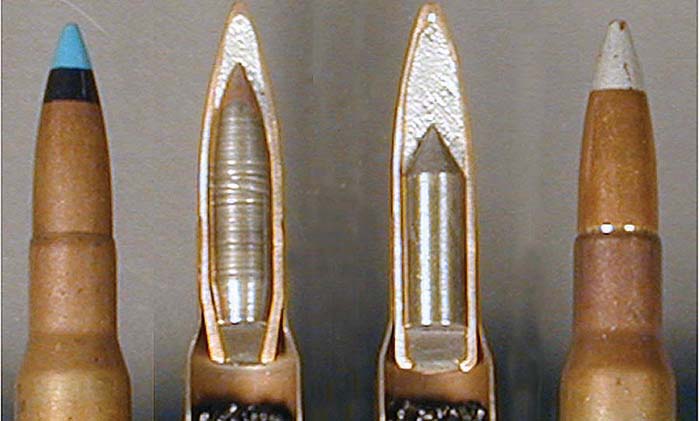
ARMOR-PIERCING INCENDIARY
While the search for a way to give the small .30-06 AP bullet an incendiary effect started in World War I, it wasn’t until World War II that they had any success. The small lead point filler between the steel core and the bullet jacket was exchanged for a small quantity of a barium nitrate/magnesium mixture called IM-11. First identified by a black and blue bullet tip and called the T15 in 1943, it was quickly changed to a silver bullet tip and called the M14 API. By the late 1940s, they had changed the shape of the AP core which allowed substantially more of the incendiary mixture to be used and this was termed the M14A1.
BLANKS
Blanks were designed to perform a variety of functions from simply noise blanks to the launching of grenades or radio antennas.
In the U.S., the first noise blanks were those using the same paper bullet as used in the .30-03 blank and these were called the M1906 Blank. The paper bullet also contained a charge of powder to facilitate its break up. Some may be found with the tinned cases and in 1909 some .30-03 blanks with this bullet were adapted to the .30-06 chamber by resizing the neck.
Due to the cost and complex production process, an alternative to the paper bullet blank was designed that had a casemouth simply roll-crimped over a tan cup-shaped wad and this was adopted as the M1909 Blank. It went through a series of improvements, the most notable of which was the use of a simple red card wad, and was the standard noise blank for the life of the .30-06.
Grenade blanks first appeared on the scene in the early 1920s. Most of these functioned on a rod-type grenade and used a heavy powder charge to propel it. These were eventually standardized as the M3 Grenade Blank in 1941. This was identified by a rose-crimped casemouth with a red seal. Also of note is that throughout its life, the powder charge was a mixture of smokeless and black powder.
One interesting grenade blank from the 1920s is that made for the Viven-Bessiere practice grenade, which functioned by using the residual gases of a ball cartridge with the bullet passing through the center of the grenade. Since the danger space of a ball round greatly exceeds the danger space for the grenade (the bullet being able to travel much further than the grenade), a blank using a solid wood bullet was designed that could launch the practice grenade in range areas too small to accommodate a full-power ball cartridge.
It is worth mentioning here that you cannot safely tell a noise blank from a grenade blank strictly by its appearance. While the U.S., for the most part, used a blank with a roll-crimped casemouth over a red wad as the service issue noise blank, other countries did not adhere to this identification. In addition, there are numerous movie blanks that used military surplus cases, with a rose-crimped casemouth. Lake City made several batches of .30-06 blanks as late as 2002 for veterans’ funerals and these had a rose-crimped casemouth.
While not a U.S. development, Norway, France and Germany made extensive use of plastics for blanks starting in the 1950s. The U.S. did not embrace plastic cartridges in small arms ammunition in those days and even now there seems to be some reluctance. Nevertheless, these are colorful variations and perhaps the most familiar in the U.S. is the blank made of gold-colored plastic that was used in the movie “The Longest Day.”
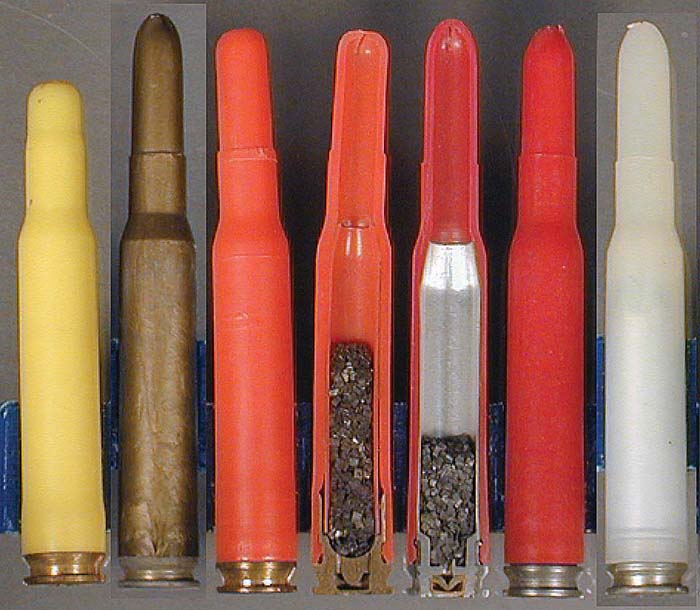
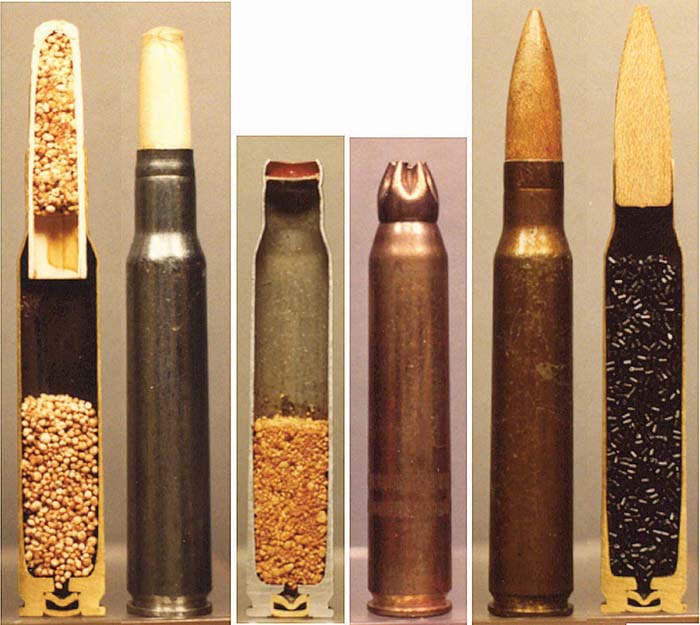
DUMMIES
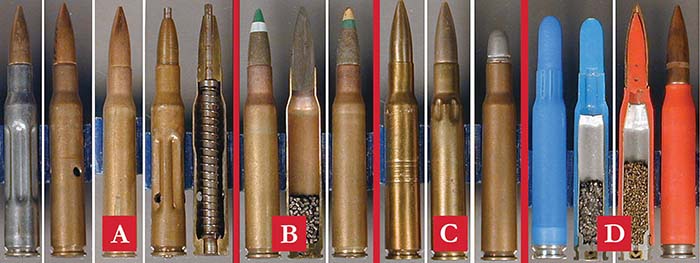
The early drill practice dummies (called the M1906 Dummy) had 6 corrugations running down the tinned case and from 1 to 4 holes in the case. It evolved, losing the tin plating, and gradually reducing the number of case holes until there were none, but retained its “Dummy M1906” designation through World War II. It was resurrected in the Korean War as the Dummy M40 and may frequently be encountered with a corrugated steel case.
Dummies for weapon functioning and inspection normally have smooth cases as corrugations might not reveal imperfections in an action or chamber. These smooth-case dummies first appeared at the end of World War I. These were usually tinned with two holes in the case. In 1938 a similar dummy, called the M2, was introduced with the tinned case and from one to three holes. It was made through the 1950s and is often seen with a plain brass or steel case.
The Range Dummy is, as far as we know, unique to the .30-06. It appeared in 1920 as a device for detecting flinching with recruits on the firing range. Identified only by a tinned primer and a groove cut in the head of the case, it was slipped into a magazine by the instructor without the knowledge of the recruit. It remained in use in some places until the early 1940s.
Perhaps the oddest .30-06 dummy is that intended for the Hollifield Target Practice Rod device. A special rod with a sharp point was fitted into the rifle barrel. The “Dotter” cartridge also had a rod in it and when it was “fired” the blow was transmitted to the rod in the barrel which popped out and pricked a paper target hung just in front of the muzzle. Designed in 1908 it was used extensively through World War I.
FRANGIBLE
The development of the frangible cartridge (i.e.: where the bullet breaks up on impact without damaging the target) illustrates the challenges endured by developers faced with different requirements from each branch of the Armed Forces.
In the early 1940s, the basic idea was to be able to train bomber gun crews by having them fire at real aircraft. Initially the Air Force approached the Ordnance Department but nothing happened. To cut a long story short, the NDRC (National Defense Research Committee – a civilian “think-tank”) was contacted. Duke and Princeton Universities got involved and eventually developed the frangible cartridge two years later. The mottled green/gray bullet was a mixture of bakelite and powdered lead referred to as RD-42-93. It was identified by a green and white bullet tip and muzzle velocity was a mere 1,360 fps. It was initially called the T44 Frangible but formally accepted in April, 1945 as the M22. A minor variation, the T74, using a tan over green bullet tip was developed in 1945 using a different propellant. By this time, the limited value of .30 cal. aircraft armament had been realized and most aircraft had been upgraded to .50 cal. machine guns.
GUARD & GALLERY
While these were initially considered separate loadings, they eventually filled both functions. The first Guard cartridges appeared in 1907 for use by sentries at military installations and prisons in urban areas. They were identified by 5 cannelures in the middle of the case and had a very small powder charge (muzzle velocity was 1,200 fps). The cannelures were its downfall as the case would separate in a dirty chamber. The identification was then changed to 6 short corrugations on the case shoulder. Production ceased about 1918 though it was still issued for a number of years after that.
Gallery or “Short-range” cartridges were used for training purposes. Up until 1919, various solutions were tried and the most common being a 198-grain pointed lead bullet called the “Ideal” bullet. It was replaced by a 140-grain lead bullet that became the Gallery Practice M1919. This nomenclature was changed again in 1933 when it became the M1 Guard Cartridge.
Countries like Norway and Germany used plastic cases and/or plastic bullets in .30-06 short-range cartridges from the 1950s. Again, these did not prove popular in the U.S.
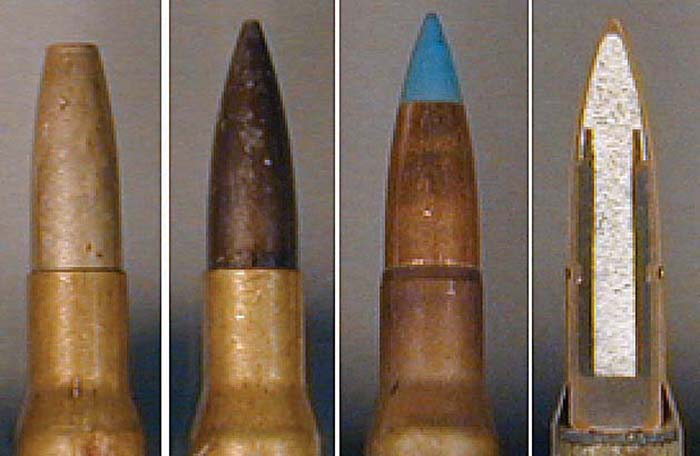
INCENDIARY
The earliest .30-06 incendiary round was the M1917 which had a charge of white phosphorous and was identified by a flat tip bullet. The side of the bullet had a small hole that was sealed with solder which melted as the bullet traveled down the barrel – igniting the phosphorous on contact with the air.
This was quickly replaced by the M1918 which was identical internally but had a blackened pointed bullet to match the trajectory of the ball cartridge of the day. With experience passed on from the R.A.F. following the Battle of Britain, the U.S. was able to develop a bullet with a charge of barium nitrate/magnesium as the incendiary agent inside a steel sleeve. It was identified by a blue bullet tip and was accepted as the M1 Incendiary in 1941. It remained virtually unchanged for the rest of its service life.
SPORTING
While sporting cartridges are beyond the scope of this article, it is worth mentioning one commonly encountered load that had a military connection. It was made by Remington with a 280-grain round-nose soft-point bullet and packaged in military style boxes with a government contract number. Folk-lore has its purpose as protecting Alaskan bases from polar bears. As has recently been discovered, these were actually a contract for Springfield Armory in Massachusetts for their heavy recoil tests of 1955.
TRACER
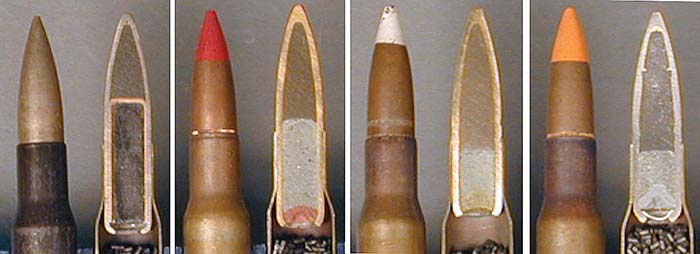
The earliest .30-06 tracer you are likely to encounter is the M1917, which was identified by a chemically blackened case and used through World War I. The bullet had a cupronickel jacket until 1921 when it was changed to gilding metal.
In the 1920s there was considerable effort to improve the tracer with the M1923 and then the M1924 Tracers being adopted, both identified by black cases. It was renamed the “M1 Tracer” in 1926 and in 1930 the identification was changed from a black case to a red bullet tip. It remained in service into World War II when the differing requirements of air and ground wars triggered further development. Like its ball counterpart, the use of steel jackets was permitted in 1943 and packaging may be seen labeled “M1 Alternate Tracer.”
While the M1 tracer was used until the end of WW2, a short-trace version was developed in 1942 and became the “M2 Tracer.” Initially it was identified by a white bullet tip but this was quickly changed to a red bullet tip with an additional knurled cannelure on the bullet. Also in 1942, the Air Force voiced the need for a dark-ignition trace; one that would not blind the pilot. The result was a dim-ignition tracer at first called the T10 and later adopted as the M25 in 1945 with an orange tipped bullet. It remained the standard tracer for the rest of the .30-06’s military life.
SPECIAL PURPOSE LOADINGS
While there were many experimental loads developed in its first 50 years, we will concentrate here on a few of the unusual loads that illustrate the .30-06 usage in the 1950s and 60s.
Multiball

The concept of firing multiple projectiles with one shot is as old as ammunition itself. As far as the .30-06 is concerned there were experiments by Greener of the UK in the post World War I period with duplex and triplex loads being developed. In the U.S., it wasn’t until Project Salvo (1952-1961) that serious development took place along these lines. Commonly seen with both the standard length case and ones with an extended neck holding two or three bullets, these were developed by Olin (who owned Winchester-Western). Of note is the powder charge between the bullets to ensure separation and the fact that they had to angle the base of the lower bullets to ensure sufficient dispersion to make it worth while. Some of these rounds had colored bullet tips to identify special lots.
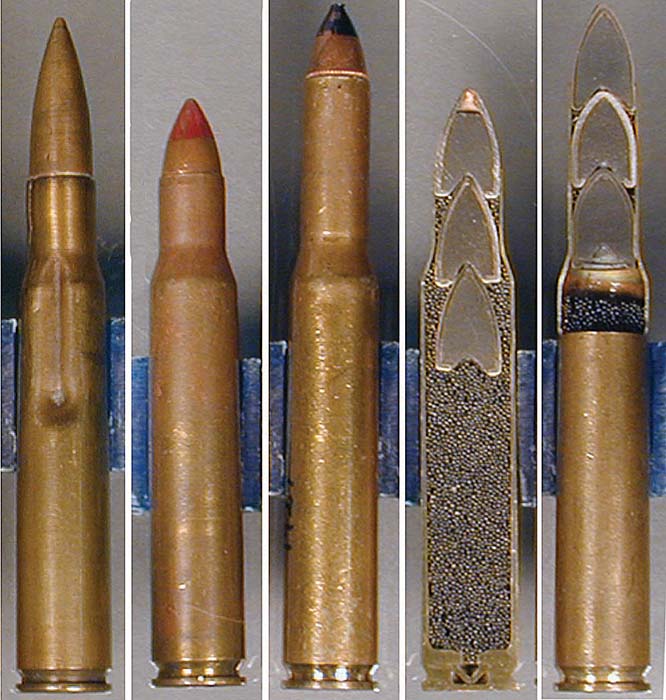
Explosive/Observation
These were designed to either increase damage to a target or to indicate the point of impact – often in a sub-caliber device. There were World War I experiments with a blunt-nose bullet with protruding nipple/firing pin, and World War II experiments using the Pomeroy bullet done by Winchester. The latter bullet is notable in that it has a capsule of dynamite in the nose activated by the bullet’s rotation. Both Frankford Arsenal and Winchester developed observation bullets with a complex internal mechanism called the T99. These appeared in the early 1950s and were identified by a yellow bullet tip. (A yellow bullet tip was used on a number of experimental loadings and not just observation rounds).
Silent Cartridge
Nothing illustrates the changing use of the .30-06 more than the silent .30-06 cartridge. Using the captive bolt principle, these were an all-steel assembly where a piston propelled a steel bullet that had a nylon driving band. It was developed in the 1960s and eventually patented in 1977. The same concept was applied to the QSPR (Quiet Special Purpose Revolver) rounds for the Viet Nam “Tunnel Rats.”
DUDS
Most will be familiar with the Remington “Accelerator” round that uses a .223-cal. bullet in a plastic sabot to provide a high velocity round as pictured in the lead photo on page 42. The concept was used on what is probably one of the .30-06’s rarest loadings – the Depleted Uranium Discarding Sabot (DUDS). This armor-piercing round was developed during the 1960s and 70’s and used the plastic sabot to hold the uranium slug.
These represent just a few of the special purpose loadings from this era. Others include manstopper, helmet test, radio destructor, flare and tear-gas loads.
U.S. Manufacturers
While many military and commercial manufacturers made the .30-06, this is a listing of the main U.S. Military manufacturers. The headstamp letters used are shown in parenthesis.
- Frankford Arsenal, Philadelphia (FA, FAL) made .30-06 from 1906 until ~1961. It closed in 1977.
- Denver Ordnance Plant, Colorado (DEN) made .30-06 from 1941-1944.
- Des Moines Ordnance Plant, Iowa (DM) made .30-06 from 1942-1945.
- Eau Claire Ordnance Plant, Wisconsin (EC/EW **), made .30-06 from 1942-1943. (** Initially they used “EC” on the headstamp but this was changed to “EW” to avoid confusion with Evansville Chrysler – which didn’t actually make .30-06).
- Lake City Ordnance Plant / Lake City Arsenal / Lake City Army Ammunition Plant, Independence, Missouri (LC), made .30-06 from 1941-1945, 1951-late 1970s, 1993, 2002. Also produced the clandestine headstamp “C / N [false date]” in 1953.
- St. Louis Ordnance Plant, Missouri (SL), made .30-06 from 1941-1945, 1952-1957. Also produced the clandestine headstamp “B / N [false date]” in 1953.
- Twin Cities Ordnance Plant, Minneapolis (TW), made .30-06 from 1942-1945, 1951-1957. Also produced the clandestine headstamp “A / N [false date]” in 1953.
- Utah Ordnance Plant, Salt Lake City, (U, UT), made .30-06 from 1942-1943.
The big commercial companies like Winchester-Western, Remington, Peters, United States Cartridge Company (U.S.C.Co.) and UMC also made .30-06 on government contract at various times.
Chris Punnett is author of the book “.30-06” and Editor of the International Ammunition Association’s Journal (http://cartridgecollectors.org).
| This article first appeared in Small Arms Review V10N1 (October 2006) |











